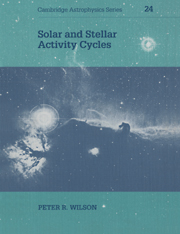Book contents
- Frontmatter
- Contents
- Preface
- Acknowledgments
- 1 Introduction
- 2 Historical survey
- 3 The structure of the Sun and the phenomena of activity
- 4 The equations of magnetohydrodynamics and magnetohydrostatics
- 5 The one-dimensional configuration of the cycle
- 6 Heuristic models of the solar activity cycle
- 7 Stellar activity and activity cycles
- 8 The two-dimensional representation of the extended activity cycle
- 9 The origin of the large-scale fields
- 10 The reversal of the polar magnetic fields
- 11 The role of dynamo theory in cyclic activity
- 12 Helioseismology and the solar cycle
- 13 Cyclic activity and chaos
- 14 Forecasting the solar cycle
- 15 Summary and conclusions
- Author index
- Subject index
5 - The one-dimensional configuration of the cycle
Published online by Cambridge University Press: 27 October 2009
- Frontmatter
- Contents
- Preface
- Acknowledgments
- 1 Introduction
- 2 Historical survey
- 3 The structure of the Sun and the phenomena of activity
- 4 The equations of magnetohydrodynamics and magnetohydrostatics
- 5 The one-dimensional configuration of the cycle
- 6 Heuristic models of the solar activity cycle
- 7 Stellar activity and activity cycles
- 8 The two-dimensional representation of the extended activity cycle
- 9 The origin of the large-scale fields
- 10 The reversal of the polar magnetic fields
- 11 The role of dynamo theory in cyclic activity
- 12 Helioseismology and the solar cycle
- 13 Cyclic activity and chaos
- 14 Forecasting the solar cycle
- 15 Summary and conclusions
- Author index
- Subject index
Summary
A point once said to a line
‘It is a belief of mine
that it's merely pretension
to claim a dimension’
PunchIntroduction
The standard concept of the sunspot cycle is of an 11-year variation in the number of sunspots present on the Sun, N(t), at time t. The data from which N(t) must be determined are the daily values of the Zurich sunspot number Rz (defined in §2.5), but, because only half the Sun is visible at any one time, Rz is a measure of the number of spots on the visible hemisphere, and it is not possible, even in principle, to determine N(t) at any instant t. For this reason N(t) must be derived from a time average of Rz over a longer period, such as a Carrington rotation or a calendar year. The variable t is therefore discrete rather than continuous, and the function N(t) is strictly a sequence, Ni, which represents twice the mean value of Rz during the ith time interval.
The sunspot number Rz is not the only scalar quantity that exhibits cyclic variations with an 11-year period. Other such quantities include total sunspot area, active region counts, flare counts, the strength of Call emission, the 10 cm radio flux, the incidence of aurorae, the flux of cosmic rays as measured through certain indicators, and even the widths of terrestrial tree rings. Each of these quantities exhibits a slightly different pattern of variation, and the investigation of the various time series can provide different insights into the nature of the cycle. Such a variety of indicators must, however, raise the question as to what is the fundamental physical variable which generates these variations in secondary phenomena which we call the solar cycle.
- Type
- Chapter
- Information
- Solar and Stellar Activity Cycles , pp. 69 - 82Publisher: Cambridge University PressPrint publication year: 1994



